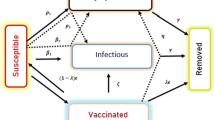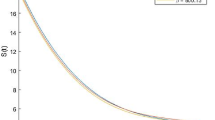Abstract
Recently, numerous demonstrative investigations on the mathematical modelling and analysis of Covid-19 have been performed. In this regard, a mathematical model is introduced to demonstrate the effects of vaccination on Covid-19. This study presents the five compartmental groups of the model, namely susceptible, infected, exposed, recovered groups, and vaccinated people. To make the model more realistic, the existing integer-order system has been modified using the Mittag–Leffler kernel. The formation of a fractional-order model shows the validity of this generalization with memory. In addition to the positivity solution, existence, uniqueness, and biologically feasible region are considered. The Ulam–Hyers stability is established through fixed-point theory and nonlinear analysis. The basic reproduction number, which means the number of people predicted to be secondarily infected among the susceptible population, is calculated. The considered model is assessed by using the Atangana–Baleanu fractional operator, and the fractional Adams–Bashforth numerical technique based on Lagrange polynomial interpolation is adopted to solve the model. Further, the error analysis of the present method has also been included. The behaviour of the solution is demonstrated through numerical simulations with the help of graphical representations.






Similar content being viewed by others
References
World Health Organization Weakly Report, https://www.who.int/publications/m/item/weekly-epidemiological-update---5-january-2021
World Health Organization. https://covid19.who.int
J Zu, M L Li, Z F Li, M W Shen, Y N Xiao and F P Ji, Infectious Diseases of Poverty 9, 1 (2020)
B Tang, F Xia, S Tang, N L Bragazzi, Q Li, X Sun, J Liang, Y Xiao and J Wu, Int. J. Infectious Diseases 96, 636 (2020)
A Ahmed, B Salam, M Mohammad, A Akgul and S H A Khoshnaw, AIMS Bioengineering 7, 130 (2020)
D Okuonghae and A Omame, Chaos, Solitons and Fractals 139, 110032 (2020)
B H Foy, B Wahl, K Mehta, A Shet, G I Menon and C Britto, Int. J. Infectious Diseases 103, 431 (2020)
J Farooq and M A Bazaz, Chaos, Solitons and Fractals 138, 110148 (2020)
C Xu, M Farman, A Hasan, A Akgül, M Zakarya, W Albalawi and C Parkg, Alexandria Engineering J. 61(12), 11787 (2022)
A Akgül, N Ahmed, A Raza, Z Iqbal, M Rafiq, D Baleanu and M A Rehman, Results in Phys. 20, 103663 (2021)
R M Jena, S Chakraverty and S K Jena, Chaos, Solitons & Fractals 141, 1 (2020)
R M Jena, S Chakraverty and D Baleanu, Math.Computers in Simulation 182, 514 (2020)
S Chakraverty, R M Jena and S K Jena, Synthesis Lectures on Mathematics and Statistics, Morgan & Claypool Publishers (2020)
R M Jena, S Chakraverty, M Yavuz and T Abdeljawad, Mod. Phys. Lett. B 35(30), 2150443 (2021)
S P Kaur and V Gupta, Virus Res. 288, 198114 (2020)
M Yavuz, F Ö Coşar, F Günay and F N Özdemir, Open J. Modelling and Simulation 9, 299 (2021)
M Caputo and M Fabrizio, Prog. Fract. Differ. Appl. 1, 73 (2015)
V F Morales-Delgado, J F Gómez-Aguilar and M A Taneco-Hernandez, Int. J. Electron. Commun. 85, 61 (2018)
Z Li, Z Liu and M A Khan, Chaos Solitons Fractals 131, 109528 (2020)
S Qureshi and A Atangana, Chaos Solitons Fractals 136, 109812 (2020)
R Ali, A Akgül and M I Asjad, Pramana – J. Phys. 94, 131 (2020)
M N Khan, I Ahmad, A Akgül, H Ahmad and P Thounthong, Pramana – J. Phys. 95, 6 (2021)
L N Huynh, N H Luc, D Baleanu and L D Long, J. Inequal. Appl. 2021, 28 (2021)
P Sunthrayuth, A Alderremy, S Aly, R Shah and A Akgül, Pramana – J. Phys. 95, 201 (2021)
A Atangana and D Baleanu, Therm. Sci. 20, 1 (2016)
A Atangana and S I Araz, Alex. Eng. J. 59(4), 2355 (2020)
A Atangana and S I Araz, Adv. Differ. Equ. 2021, 57 (2021)
A Atangana, Alex. Eng. J. 60(4), 3781 (2021)
A Atangana and S I Araz, Adv. Differ. Equ. 2020, 659 (2020)
M. Farman, A Akgül, M U Saleem, S Imtiaz and A Ahmad, Pramana – J. Phys. 94, 164 (2020)
J Kongson, W Sudsutad, C Thaiprayoon, J Alzabut and C Tearnbucha, Adv. Difference Equations 2021, 356 (2021)
M Mandal, S Jana, S K Nandi, A Khatua, S Adak and T K Ka, Chaos, Solitons and Fractals 136, 109889 (2020)
Z M Odibat and N T Shawagfeh, Appl. Math. Comput. 186(1), 286 (2007)
X Q Zhao, Dynamical Systems in Population Biology, Springer, Cham (2017) 285 pages
C Castillo-Chavez, Z Feng and W Huang, Mathematical Approaches for Emerging and Reemerging Infectious Diseases: An Introduction, Springer, Berlin (2002) vol. 125
Z Ali, A Zada and K Shah, Bull. Malays. Math. Sci. Soc. 42(5), 2681 (2019)
M S Abdo, S K Panchal, K Shah and T Abdeljawad, Adv Differ Equ. 249, 2020 (2020)
W Werner, Math. Computation 43, 205 (1984)
T F Krogh, Math. Computation 24, 185 (1970)
M Toufik and A Atangana, The European Physical J. Plus 132, 444 (2017)
Acknowledgements
The first author, Rajarama Mohan Jena acknowledges the Department of Science and Technology, Government of India, for providing an INSPIRE Fellowship (IF170207).
Author information
Authors and Affiliations
Corresponding author
Additional information
Publisher's Note
Springer Nature remains neutral with regard to jurisdictional claims in published maps and institutional affiliations.
Rights and permissions
About this article
Cite this article
Jena, R.M., Chakraverty, S., Zeng, S. et al. Non-singular kernel-based time-fractional order Covid-19 mathematical model with vaccination. Pramana - J Phys 97, 177 (2023). https://doi.org/10.1007/s12043-023-02624-y
Received:
Revised:
Accepted:
Published:
DOI: https://doi.org/10.1007/s12043-023-02624-y
Keywords
- Atangana–Baleanu fractional derivative
- Adams–Bashforth numerical method
- Covid-19 model
- vaccination
- Ulam–Hyers stability
- fixed point theorem




